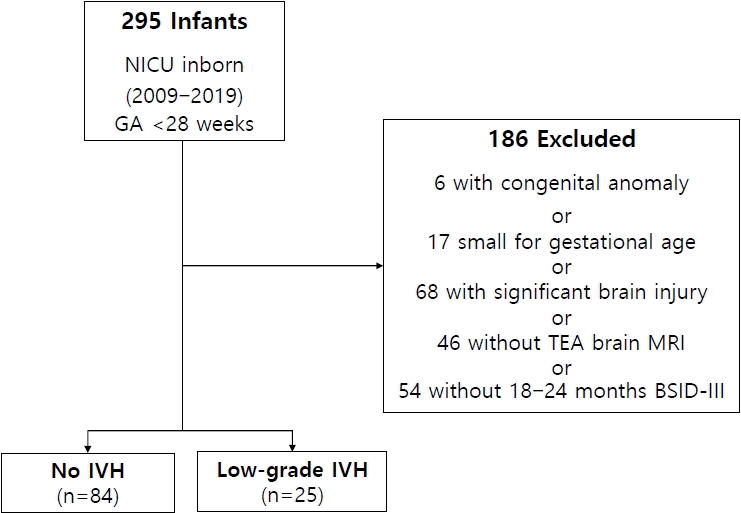1. Inder TE, Perlman JM, Volpe JJ. Intracranial hemorrhage: subdural, subarachnoid, intraventricular (term infant), miscellaneous. In : Volpe JJ, Inder TE, Darras BT, de Vries LS, du Plessis AJ, Neil JJ, editors. Volpe's neurology of the newborn. 6th ed. Elsevier;2018. p. 593–622.
2. Larroque B, Marret S, Ancel PY, Arnaud C, Marpeau L, Supernant K, et al. White matter damage and intraventricular hemorrhage in very preterm infants: the EPIPAGE study. J Pediatr. 2003; 143:477–83.

3. Cust AE, Darlow BA, Donoghue DA; Australian and New Zealand Neonatal Network (ANZNN). Outcomes for high risk New Zealand newborn infants in 1998-1999: a population based, national study. Arch Dis Child Fetal Neonatal Ed. 2003; 88:F15–22.

4. Bolisetty S, Dhawan A, Abdel-Latif M, Bajuk B, Stack J, Lui K, et al. Intraventricular hemorrhage and neurodevelopmental outcomes in extreme preterm infants. Pediatrics. 2014; 133:55–62.

5. Reubsaet P, Brouwer AJ, van Haastert IC, Brouwer MJ, Koopman C, Groenendaal F, et al. The impact of low-grade germinal matrix-intraventricular hemorrhage on neurodevelopmental outcome of very preterm infants. Neonatology. 2017; 112:203–10.

6. Limperopoulos C, Chilingaryan G, Guizard N, Robertson RL, Du Plessis AJ. Cerebellar injury in the premature infant is associated with impaired growth of specific cerebral regions. Pediatr Res. 2010; 68:145–50.

7. Keunen K, Isgum I, van Kooij BJ, Anbeek P, van Haastert IC, Koopman-Esseboom C, et al. Brain volumes at term-equivalent age in preterm infants: imaging biomarkers for neurodevelopmental outcome through early school age. J Pediatr. 2016; 172:88–95.

8. Patra K, Wilson-Costello D, Taylor HG, Mercuri-Minich N, Hack M. Grades I-II intraventricular hemorrhage in extremely low birth weight infants: effects on neurodevelopment. J Pediatr. 2006; 149:169–73.

9. Papile LA, Burstein J, Burstein R, Koffler H. Incidence and evolution of subependymal and intraventricular hemorrhage: a study of infants with birth weights less than 1,500 gm. J Pediatr. 1978; 92:529–34.

10. Yi YG, Sung IY, Yuk JS. Comparison of second and third editions of the Bayley scales in children with suspected developmental delay. Ann Rehabil Med. 2018; 42:313–20.

11. Zollei L, Iglesias JE, Ou Y, Grant PE, Fischl B. Infant FreeSurfer: an automated segmentation and surface extraction pipeline for T1-weighted neuroimaging data of infants 0-2 years. Neuroimage. 2020; 218:116946.

12. Keunen K, Kersbergen KJ, Groenendaal F, Isgum I, de Vries LS, Benders MJ. Brain tissue volumes in preterm infants: prematurity, perinatal risk factors and neurodevelopmental outcome: a systematic review. J Matern Fetal Neonatal Med. 2012; 25 Suppl 1:89–100.

13. Briana DD, Malamitsi-Puchner A. Low-grade intraventricular hemorrhage of preterm infants: neurodevelopmental and motor outcome. J Matern Fetal Neonatal Med. 2021; 34:646–52.

14. Honnorat M, Plaisant F, Serret-Larmande A, Claris O, Butin M. Neurodevelopmental outcome at two years for preterm infants with intraventricular hemorrhage: a case-control study. Pediatr Neurol. 2023; 141:52–7.

15. Lai GY, Shlobin N, Garcia RM, Wescott A, Kulkarni AV, Drake J, et al. Global incidence proportion of intraventricular haemorrhage of prematurity: a meta-analysis of studies published 2010-2020. Arch Dis Child Fetal Neonatal Ed. 2022; 107:513–9.

16. Mukerji A, Shah V, Shah PS. Periventricular/intraventricular hemorrhage and neurodevelopmental outcomes: a metaanalysis. Pediatrics. 2015; 136:1132–43.

17. Inder TE. Neurodevelopmental impact of low-grade intraventricular hemorrhage in very preterm infants. J Pediatr. 2006; 149:152–4.

18. Perisset A, Natalucci G, Adams M, Karen T, Bassler D, Hagmann C. Impact of low-grade intraventricular hemorrhage on neurodevelopmental outcome in very preterm infants at two years of age. Early Hum Dev. 2023; 177-178:105721.

19. Legge N, Lutz T, Wocadlo C, Rieger I. Long-term neurodevelopmental outcome in preterm infants with intraventricular haemorrhage. J Paediatr Child Health. 2022; 58:1797–802.

20. Steiner M, Schwarz H, Kasprian G, Rittenschober-Boehm J, Schmidbauer V, Fuiko R, et al. Brain biometry reveals impaired brain growth in preterm neonates with intraventricular hemorrhage. Neonatology. 2023; 120:225–34.

21. Inder TE, Warfield SK, Wang H, Huppi PS, Volpe JJ. Abnormal cerebral structure is present at term in premature infants. Pediatrics. 2005; 115:286–94.

22. Vasileiadis GT, Gelman N, Han VK, Williams LA, Mann R, Bureau Y, et al. Uncomplicated intraventricular hemorrhage is followed by reduced cortical volume at near-term age. Pediatrics. 2004; 114:e367–72.

23. Jeong HJ, Shim SY, Cho HJ, Cho SJ, Son DW, Park EA. Cerebellar development in preterm infants at term-equivalent age is impaired after low-grade intraventricular hemorrhage. J Pediatr. 2016; 175:86–92.

24. Tam EW, Miller SP, Studholme C, Chau V, Glidden D, Poskitt KJ, et al. Differential effects of intraventricular hemorrhage and white matter injury on preterm cerebellar growth. J Pediatr. 2011; 158:366–71.

25. Standring S, Borley NR, Gray H. Gray's anatomy: the anatomical basis of clinical practice. 40th ed. Churchill Livingstone/Elsevier;2008.
26. Tortora D, Lo Russo FM, Severino M, Parodi A, Massirio P, Ramenghi LA, et al. Regional impairment of cortical and deep gray matter perfusion in preterm neonates with low-grade germinal matrix-intraventricular hemorrhage: an ASL study. Neuroradiology. 2020; 62:1689–99.

27. Volpe JJ. Brain injury in premature infants: a complex amalgam of destructive and developmental disturbances. Lancet Neurol. 2009; 8:110–24.

28. Inui T, Kumagaya S, Myowa-Yamakoshi M. Neurodevelopmental hypothesis about the etiology of autism spectrum disorders. Front Hum Neurosci. 2017; 11:354.






 PDF
PDF Citation
Citation Print
Print



 XML Download
XML Download